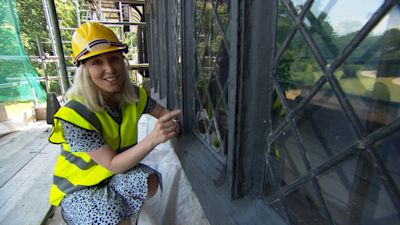Mystery surrounding wooden carved heads at Speke Hall and how a Liverpool school could hold the key

Report by Mel Barham
Nestled on the banks of the River Mersey and a stone's throw from Liverpool John Lennon airport, stands the Tudor timber-framed manor house of Speke Hall.
Originally built in 1530, the grade 1 listed building is a unique mix of Tudor simplicity and Victorian arts and crafts aesthetics, thanks to restoration during the 19th century.
But over the last year, not only has the building - now owned by the National Trust - been battered by the elements, it's also had to weather the storm of the pandemic which put a stop to planned renovation work.
That work has now finally begun and with the scaffolding up, Granada Reports was invited behind-the-scenes to have a look at the vital restoration that is currently being done on the North range of the Hall.
One of the fascinating stories that's been thrown up as part of the restoration work, rests with three wooden carved heads that were removed from the gables for repair.
Experts aren't certain how old the carvings are - they could date back to the original building in Tudor times, or they could be as recent as 1969.
That's because, when the Hall belonged to Liverpool City Council, some of the restoration work back in the 60s was done by pupils at Gateacre Comprehensive School.
They know that one section of the front elevation of the north range of the Hall was replaced with a piece of carved wood by Gateacre school, because there's an engraving and the school's crest.
What they don't know is whether the carved heads on the gables had been produced by the students as well.
A team of timber specialists at the National Trust will now try to discover the age of the wood used, but the Trust are appealing for former pupils at Gateacre Comprehensive to come forward if they can shed any light on
I was allowed up onto the scaffolding of the Tudor mansion to see first-hand some of the other restoration work being done by the team.
Up on the north range of the building, above the grand entrance to Speke Hall, they've been busy re-painting the facade.
But of course, its not just any old paint they've been using.
The team have been using traditional products and techniques to ensure the building retains its authenticity.
The painters tasked with the job have been using lime wash and micro-porous architectural black paint.
And they told me its a bit like painting the Forth Bridge - because as soon as they've done one side of the building, they will need to do the next side the following year.
A brief history of Speke Hall